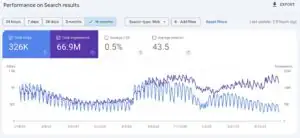As companies grow and internationalise, they face increasing challenges. One of the most important is how to establish a presence, both physical and digital, in these new regions. This article focuses on digital presence, more specifically, on how to optimise global enterprise sites for multilingual & multi-market search, covering the technical, cultural, and emerging trends shaping international search today.
Why international search optimisation matters for large enterprises
Global enterprises often operate in multiple markets, but search visibility rarely transfers seamlessly from one country to another. Local competitors, language nuances, search preferences, and now AI-driven results create new barriers.
For example:
- Search engine variety: Google dominates globally, but in China (Baidu), South Korea (Naver), and Russia (Yandex), other search engines lead.
- Customer search behaviour varies: the same service might be searched differently in Germany, Brazil, or India.
- AI Overviews are reshaping visibility: Google’s generative AI summaries often pull content from a handful of sources, increasing competition for top placement.
- Generative engine optimisation is becoming essential: brands must now optimise for both traditional search ranking and AI-driven answer engines.
By optimising for international search, large enterprise businesses can:
- Drive relevant traffic in each market.
- Improve conversions through localisation.
- Secure visibility in both traditional search results and AI-generated answers.
- Reduce duplication issues and wasted spend.
Key steps to optimise global enterprise sites for multilingual & multi-market search
1. Define a dual strategy: SEO + GEO
Large multi-national corporations (MNCs) often operate across different countries with multiple languages, regulatory requirements, and product lines. They need a global framework that defines core SEO principles but allows local teams to customise content for each market.
- Enterprise marketing teams must plan for both international SEO and GEO, implementing a global framework but with content localisation.
- If resources are constrained, prioritise markets based on demand, revenue, and competition.
- Language vs. country: For example, decide if Spanish content should differ for Spain and Latin American countries.
- AI-first mindset: Identify where your content can appear in Google AI Overviews or ChatGPT answers – typically by focusing on informational, high-authority content.
- GEO focus: create structured, authoritative content designed to be cited in AI-generated responses (Google AI Overviews, ChatGPT, Copilot, etc.).
For example, a multinational consumer electronics company may face restrictions on the type of smart home products they can sell in the EU and Asia. The website would need to be optimised with region-specific content that reflects local regulations, electrical standards, and even prevents certain products from being visible in restricted markets.
2. Structure your website for international search

- Subdomains (fr.example.com): easier to manage, less local authority.
- Subdirectories (example.com/fr/): scalable, authority is consolidated.
- ccTLDs (example.fr): strong local trust, but harder to manage.
Most enterprises benefit from subdirectories + hreflang, ensuring consistency across markets. The impact of digital PR activities is much greater in this configuration, as links earned boost the entire domain’s authority. For GEO, this structure still allows crawlers to easily understand the context of multilingual versions of the site, so long as hreflang is used.
3. Implement hreflang correctly
Hreflang is an HTML attribute used in international SEO to signal which language and regional version of a page to show. Done right, it prevents duplicate content issues and can improve your international user experience.
Best practices:
- Correct ISO codes (en-gb, es-mx).
- Reciprocal referencing across pages.
- Use XML sitemaps or on-page tags consistently.
Large enterprise sites with English content that’s duplicated across multiple markets (e.g. USA, Canada, UK, India) need to pay special attention to this. At AccuraCast, we’ve also found it’s more important to invest in regional link building to prevent Google from over-riding hreflang settings and selecting other canonical versions of pages in this situation.
For AI Overviews, correctly set hreflang also helps Google’s systems select the most relevant version to surface globally.
4. Localise content beyond translation

- Do keyword research in each market, don’t just translate your content.
- Adapt tone, imagery, and CTAs to cultural expectations.
- Be mindful of compliance and context in each market.
As an example, when a global automotive brand localises content, they need to reflect local driving laws, fuel standards, and popular vehicle configurations in each market.
Enterprises with overly centralised marketing teams often face challenges when localising content. Recognising the importance of local customs and lingo can be the difference between customers selecting your brand and a local competitor.
5. Optimise content for generative search engines
Generative AI search experiences are changing how enterprises appear online. Traditional SEO alone is no longer enough.
Key GEO tactics:
- Answer-focused content: Write in Q&A formats, FAQs, how-tos, and summaries that AI engines can easily lift.
- Structured data: Implement schema to make your content machine-readable.
- Authority building: Highlight author expertise, cite credible sources, and use E-E-A-T principles (Experience, Expertise, Authoritativeness, Trustworthiness) to establish your content’s worthiness.
- Content depth: Generative engines favour comprehensive, well-structured information.
6. Adapt tactics for AI Overviews & generative AI search

AI search optimisation tactics:
- Optimise beyond keywords: Think beyond short queries. Users today ask questions, often in great detail. Content should anticipate user intent with direct, helpful, and well-structured answers that AI can easily summarise.
- Adapt brand signals: As mentioned in our article linked above, the fall in organic search traffic isn’t necessarily a bad thing. But marketers need to adapt performance measurement to the new reality. Mentions, reviews, and authoritative third-party references matter more in AI-driven search rankings.
- Experiment with AI-native advertising: we’re entering a world where AI-native ad formats (sponsored answers, conversational placements) will become critical. Brands that learn to blend organic GEO efforts with paid opportunities in generative search will stay ahead of the curve.
7. Strengthen technical SEO across markets
Technical SEO ensures your site performs reliably across all regions and devices. Large enterprise web teams manage complex infrastructure, multiple domains, and high traffic volumes. Technical SEO considerations like crawl budget, crawl efficiency, availability, speed, and indexability become important considerations.
- Crawl discovery: Large enterprise sites are more likely to struggle with having a higher percentage of their content indexed by Google and Bing. Maximising discoverability is half the battle for enterprise websites.
- Speed: Use of CDNs can reduce latency globally and also reduce the direct server load during peak periods.
- Implement proper redirects: Use 301 redirects for moved or outdated pages to preserve link equity and maintain a smooth user experience across regions. This also helps with crawl efficiency.
- Canonical tags & hreflang: Avoid content duplication across market versions, and preserve crawl budget for only canonical (primary) versions of your pages.
These fundamentals ensure crawlability and indexability across multiple markets and platforms.
8. Align paid and organic search internationally
Combining SEO and paid advertising campaigns amplifies visibility across markets. Paid search can inform organic strategies while SEO ensures landing pages perform for both humans and AI engines.
- SEO and PPC should reinforce each other.
- Use PPC to test market-specific keywords.
- Apply learnings to long-term SEO strategies.
- Ensure landing pages used in paid campaigns are also LLM-friendly, semantically structured, and localised.
Enterprises can leverage cross-market data at scale. Paid campaigns test keywords, messaging, and AI performance across regions, feeding insights back to organic SEO strategy.
At AccuraCast, we recommend integrating SEO, paid media, and GEO strategies so enterprise clients dominate across both organic and paid search results.
9. Measure, monitor, and adapt
Continuous measurement is key to staying competitive globally. Track rankings, traffic, AI visibility, and competitor activity to refine your strategy. International search is dynamic, and ongoing adaptation keeps your brand ahead.
Track performance across:
- Local keyword rankings.
- Traffic and conversions per market/language.
- AI Overview presence — tools are emerging to monitor generative search visibility.
- Competitor benchmarks.
Adobe Analytics, Google Analytics 360 and Piwik Pro offer server-side tracking solutions. Investing in robust tracking will future-proof your performance measurement. Setting business intelligence solutions and marketing dashboards to monitor granular traffic changes can pre-empt problems before they become critical.
Common pitfalls to avoid
1. Using automated translation only
Once the main website is translated, many companies, whether due to lack of time or resources, rely on tools like Google Translate to create multilingual content for their blogs and new product details or pages.
While this helps speed up processes, the final results are often not appropriate for each region: incorrect terminology and cultural missteps can negatively affect organic search visibility. What’s worse is the audience perceive that the brand isn’t investing in its market and getting to know them more deeply.
2. Ignoring local search engines other than Google

Success requires researching different algorithms, tailoring content formats, and even understanding compliance or platform-specific ranking factors. For example, optimising for Baidu in China or Yandex in Russia often involves different metadata, indexing rules, and content practices than Google.
Meta descriptions are less influential for rankings on Baidu, while meta descriptions influence click-throughs more than rankings on Yandex.
3. Over-relying on generic content without local context
Publishing identical content across regions reduces relevance and engagement. Local signals such as region-specific examples, currency, regulations, cultural references, or local case studies, can help search engines and AI recognise your content as authoritative for that market.
Properly incorporating local signals boosts visibility, builds trust, and improves conversion by speaking directly to local audiences.
4. Not preparing for AI search
With Google’s AI Overviews and other generative search platforms reshaping the way people discover, brands that fail to adapt risk being invisible where users increasingly start their journey.
Competitors who invest in GEO and AI-readiness now are more likely to dominate those prominent summary boxes, capturing awareness and traffic that lagging enterprises miss.
Global expansion brings complexity, but also great opportunity. Enterprises that optimise their sites for multilingual and multi-market search, while embracing personalisation and AI, will gain a critical competitive edge.
AccuraCast can help you achieve this.
About the Author
Ruben is a digital marketing consultant at AccuraCast, in charge of developing and executing effective digital marketing strategies. His specialities include digital strategy, paid media and programmatic for financial services brands.











